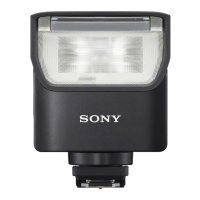
Do you have a question about the Sony HVL-F28RM and is the answer not in the manual?
| Type | Compact flash |
|---|---|
| Product color | Black |
| Color temperature | 5500 K |
| Operating frequency | 2400 MHz |
| Approximate recycling time | - s |
| Camera brands compatibility | Universal |
| Approximate recycling time (max) | 6.4 s |
| Approximate recycling time (min) | 0.1 s |
| Battery type | AA |
| Power supply type | Battery |
| Battery technology | Alkaline |
| Number of batteries supported | 2 |
| Depth | 91.4 mm |
|---|---|
| Width | 65.1 mm |
| Height | 83.5 mm |
| Weight | 219 g |
Identifies components on the front of the flash unit, including the wide panel and flashlamp.
Details the parts on the rear of the flash unit, such as the operation console and battery chamber.
Explains the function of each button and indicator on the flash unit's control panel.
Describes the components of the mini-stand accessory and its attachment points.
Lists the items included in the flash unit package and instructions for checking contents.
Provides step-by-step instructions for correctly inserting batteries into the flash unit.
Guides users on how to securely attach and detach the flash unit to a camera's hot shoe.
Explains how to attach and detach the mini-stand for standalone flash unit use.
Details the process for removing and reattaching the protective dust and moisture cover.
Instructs users on how to power the flash unit on and off, including power-saving modes.
Outlines the procedure for pairing the flash unit with a commander or receiver for wireless operation.
Explains how to use the flash unit in TTL mode for automatic exposure measurement.
Details how to set and use the flash unit in manual mode for consistent power output.
Describes how to use the flash unit with high shutter speeds for freezing motion.
Explains how to use the flash unit for capturing sequences of movement in a single image.
Guides users on how to perform test flashes to check lighting or exposure settings.
Steps to set up the flash unit as either a commander or receiver for wireless operation.
Details how to use the flash unit as a receiver unit triggered by a commander.
Explains controlling flash power distribution across multiple wireless groups.
Describes performing wireless flash photography with up to five wireless groups.
How to adjust settings for individual receiver units remotely from the commander.
Important considerations and tips for using the flash unit wirelessly.
Explains the technique of bouncing flash off surfaces for softer lighting.
Guides on setting the optimal flash head angle for bounce photography based on lens focal length.
How to save and recall frequently used flash settings (preferences).
Instructions for checking the firmware version of the flash unit and paired receivers.
A comprehensive list of all available flash settings and their options.
Advice for users whose cameras lack advanced external flash control menus.
Procedure to reset all flash firing settings back to their original factory state.
How to initialize the flash unit, clearing all data including pairing information.
Important precautions and best practices to follow during photography.
Guidance on battery types, performance, and handling precautions.
Information on operating temperature limits and handling in extreme conditions.
Locations that should be avoided for using or storing the flash unit.
Critical safety warnings to prevent hazards like fire, shock, or damage.
Instructions for cleaning and maintaining the flash unit.
Technical specifications of the flash unit itself, such as control, wireless method, and coverage.
Details on flash recycle times and the maximum number of flashes per battery set.
Data on flash output and coverage at different power levels and focal lengths.
Specifications related to the flash unit's radio wireless communication capabilities.
Lists proprietary trademarks associated with the product and its features.
